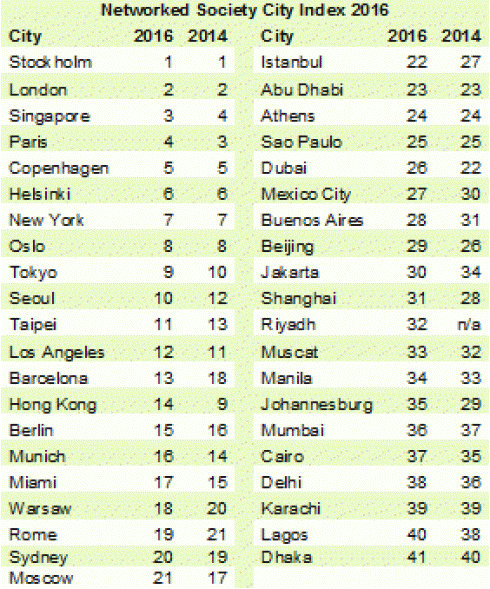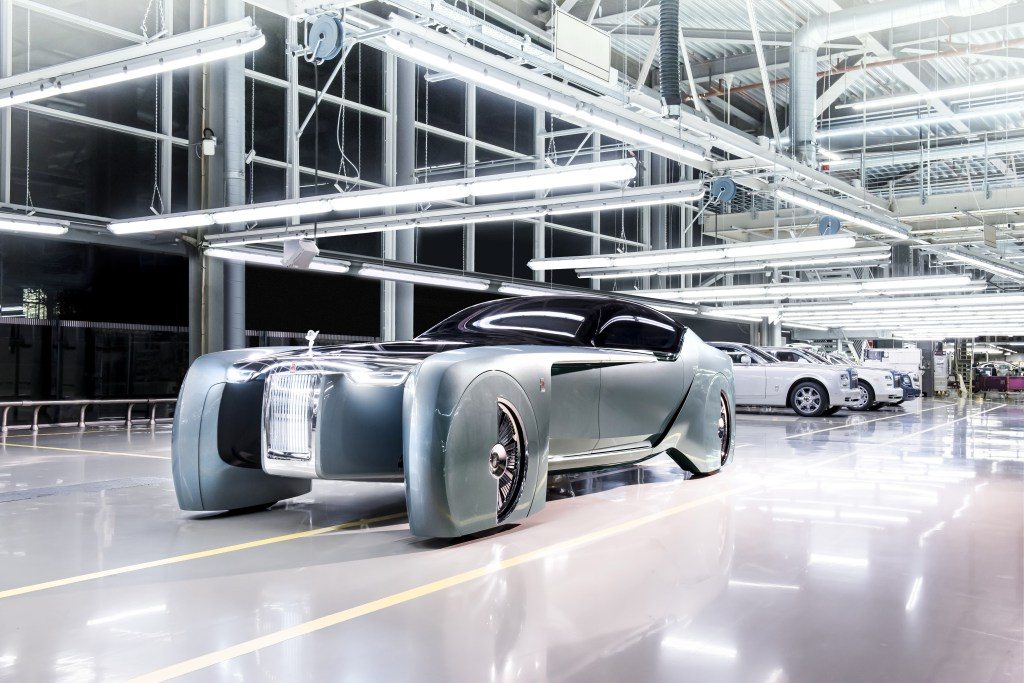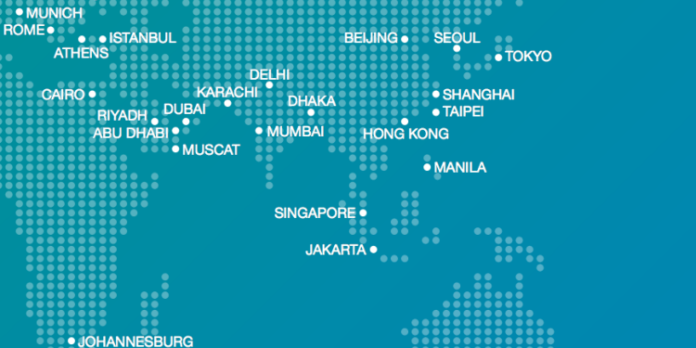Stockholm tops Ericsson’s Networked Society City Index 2016, a global smart city index measuring both sustainable urban development and ICT maturity in 41 cities around the world.
Ericsson’s global smart city league table, the Networked Society City Index 2016, ranked Stockholm as the leading smart city in the world, ahead of London, Copenhagen, Singapore and Paris. The Swedish capital city received the highest score for sustainable urban development, closely followed by Copenhagen, Helsinki and Paris. Stockholm also got the second highest score on ICT maturity, handing over its formerly top-ranking position to London. Singapore came in third.
Barcelona, Istanbul and Jakarta are among cities that have noticeably moved up in the smart city index compared to 2014. In the meantime, Hong Kong, Moscow and Dubai dropped in the ranking. ”In general, cities with low ICT maturity tend to mature faster than cities with higher ICT maturity, which indicates the presence of a catch-up effect,” said Ericsson. The telecommunications vendor has broken down ICT maturity into three variables: ICT infrastructure, ICT affordability and ICT usage. Sustainable urban development is for its part based on the so-called triple bottom line (TBL) dimensions looking at social, economic and environmental sustainability.

Smart cities not yet environmentally sustainable
Ericsson believes that smart city planning will be critical to achieving several of the United Nations 17 Sustainable Development Goals (SDGs). Those include climate action, poverty reduction, better health and education and improved social and financial inclusion. Ericsson’s Network Society City Index also shows that not even the highest ranked cities are sustainable from an environmental perspective today. “UN-Habitat estimates that 70 percent of the world’s population will reside in urban areas by 2050. Many smart city initiatives to date have mainly used ICT to optimize existing systems and behaviors, for example, intelligent transport. Instead, cities need to rethink existing structures to fully grasp the potential of ICT to make sure that ’smart’ is in fact sustainable. The future Networked Society city is characterized by resiliency, collaboration, participation and mobility, which are essential for ensuring our cities are attractive, sustainable and vibrant places,” said Erik Kruse, head of Ericsson Networked Society Lab.
ICT maturity correlated to overall development
Ericsson found that the more mature a city’s ICT is, the higher it ranks on the development ladder. Furthermore, the impact of ICT maturity is greater on social and economic indicators than on environmental ones. The vendor also noted that ICT infrastructure has improved in cities around the world as decreasing tariffs and IP transit prices worldwide have made ICT more affordable and more accessible to users.
Ericsson has made available an interactive tool to explore the Networked Society City Index and compare cities.
IIoT News Recap: Roll-Royce presents self-driving car vision vehicle; Toyota sets sights on AI-based driving systems in five years; Factom to advance blockchain-based IoT security for DHS S&T; Today’s forecast: Insurance telematics policies

Autonomous driving: Roll-Royce presents self-driving car vision vehicle
Rolls-Royce unveiled at an event in London the 103EX, a luxury self-driving ”vision vehicle”, which the automaker describes as ”a completely personal, effortless and autonomous Rolls-Royce experience”. The 103EX will come equipped with an artificial intelligence-based voice-enabled virtual assistant and chauffeur called Eleanor. “Today, Rolls-Royce, the world’s leading luxury brand, has defined the future of luxury mobility. The Grand Arrival of the Rolls-Royce Vision Next 100 boldly points to a bright future for our marque where our patrons’ individual demands for complete and authentic personalisation will be met through an exquisite fusion of technology, design and hallmark Rolls-Royce craftsmanship,” said Torsten Müller-Ötvös, CEO of Rolls-Royce Motor Cars.
Autonomous driving: Toyota sets sights on AI-based driving systems in five years
Toyota Motor Corp is planning to spend $1 billion in the next five years on self-driving car technology research and development, including the development of an artificial intelligence-based driver assistance systems, Reuters reports.
IoT security: Factom to advance blockchain-based IoT security for DHS S&T
Austin-based blockchain specialist Factom has been awarded a $199,000 contract by the Department of Homeland Security Science and Technology Directorate (DHS S&T) to advance the security of digital identity for Internet of Things (IoT) devices. “IoT devices are embedded within our daily lives – from the vehicle we drive to devices we wear – it’s critical to safeguard these devices from adversaries”, said DHS Under Secretary for Science and Technology Dr. Reginald Brothers. “S&T is excited to engage our nation’s innovators, helping us to develop novel solutions for the Homeland Security Enterprise.” The project is part of S&T’s Silicon Valley Innovation Program (SVIP). As part of the project, Factom will create an identity log capturing the identification of a device, that of its manufacturer and list available updates, known security issues and granted authorities while adding a time dimension to increase security.
Today’s forecast: 42.1 million insurance telematics policies in North America in 2020
The number of insurance telematics policies in Europe is expected to grow at a CAGR of 37.2 percent between 2015 and 2020. The number of policies will grow to 25.8 million policies by 2020, up from 5.3 million in the fourth quarter of 2015, according to new research by Berg Insight. Growth will be even faster in North America, at a CAGR of 45.8 percent, from 6.3 million policies in the fourth quarter of 2015 to 42.1 million in 2020. ”The European insurance telematics market is largely dominated by hardwired aftermarket black boxes while self-install OBD devices instead represent the vast majority of all active policies in North America,” stated Berg Insight, which anticipates a rapid increase in the uptake of solutions based on smartphones and embedded OEM telematics systems in all markets.

